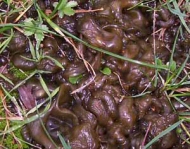Nostoc
Neither the name nor the definition — a gelatinous mass — sound at all romantic, but if I mention that nostoc’s other names include star jelly, star-shot and the Welsh pwdre sêr (“rot of the stars”), you will appreciate that there’s more to the matter.

A nostoc commune
There are many legends about it. In a translation in 1640 of van Helmont’s Ternary of Paradoxes it is suggested that nostoc may be the “nocturnal Pollution of some plethorical and wanton Star, or rather excrement blown from the nostrils of some rheumatic planet”. For centuries it was assumed to have fallen to the earth during meteor showers. In modern times it has been linked with organic detritus from unidentified flying objects or corpses of fictional atmospheric beasts. It has also been claimed to be extraterrestrial cellular matter that exists in molecular clouds in space.
Whatever you decide to call it, nostoc appears on the ground as a foul-smelling jelly-like mass. The geologist Bill Baird encountered some in Scotland in 2004. He said the lumps were about the size of a half-brick, had “the consistency of a firm blancmange” and looked like bits of a “settled fragmented snow bank”.
The real cause is more mundane than the stories. Several types of slime moulds can produce jelly-like masses when millions of individual cells clump together preparatory to producing spores. In particular, a cyanobacterium, Nostoc commune, sometimes forms filamentous colonies at the roots of grass when it is very wet.
In the eighteenth century the cyanobacterium was given the genus name of Nostoc because of this behaviour. The term nostoc had by then been around for at least two centuries in the sense of this mysterious star jelly. Despite its mundane nature, there remains one mystery about nostoc — we’ve no idea where the word comes from, not even whether it was coined in Latin or English.

